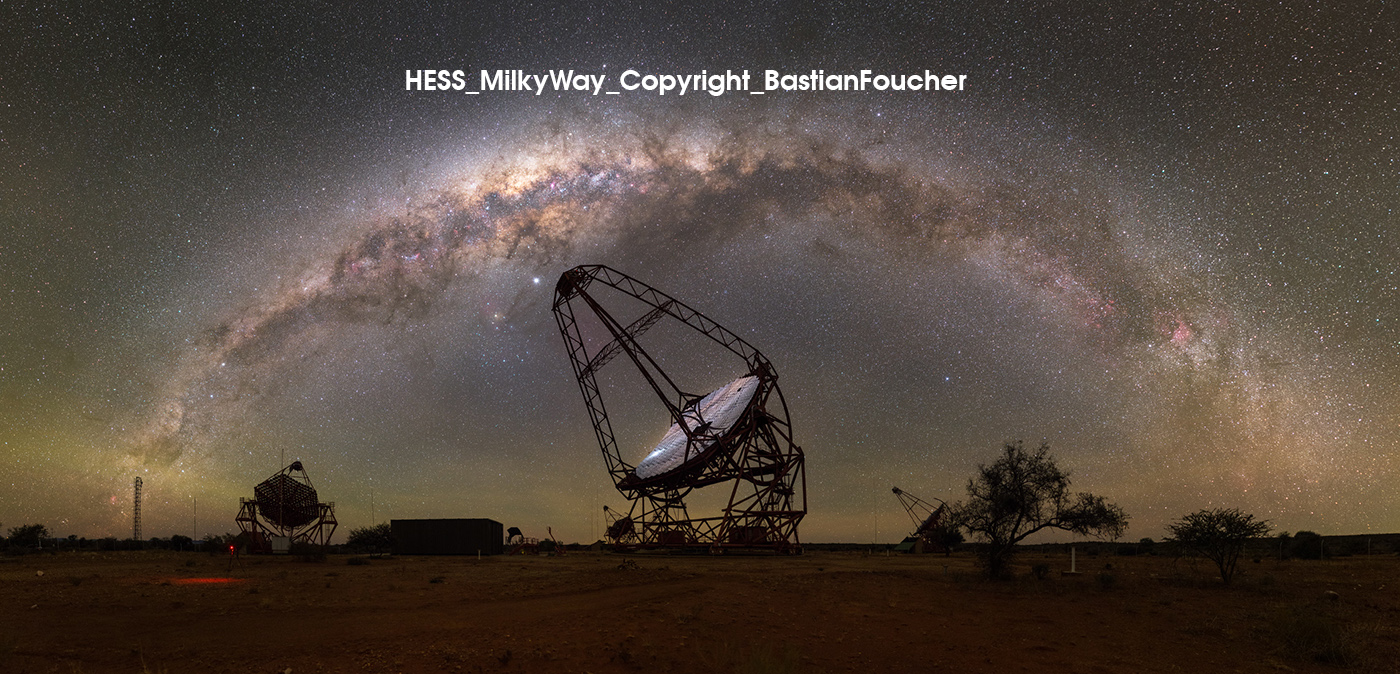The observatory records 20 TeV photons from the Vela pulsar
Scientists using the High Energy Stereoscopy System (H.E.S.S.) observatory in Namibia have detected the highest energy gamma rays ever from a dead star called a pulsar. The energy of these gamma rays clocked in at 20 teraelectronvolts, or about ten trillion times the energy of visible light. This observation is hard to reconcile with the theory of the production of such pulsed gamma rays, as the international team reports in the journal Nature Astronomy.

Pulsars are the left-over corpses of stars that spectacularly exploded in a supernova. The explosions leave behind a tiny, dead star with a diameter of just some 20 kilometres, rotating extremely fast and endowed with an enormous magnetic field. “These dead stars are almost entirely made up of neutrons and are incredibly dense: a teaspoon of their material has a mass of more than five billion tonnes, or about 900 times the mass of the Great Pyramid of Giza,” explains H.E.S.S. scientist Emma de Oña Wilhelmi, a co-author of the publication working at Deutsches Elektronen-Synchrotron (DESY) in Germany.
Pulsars emit rotating beams of electromagnetic radiation, somewhat like cosmic lighthouses. If their beam sweeps across our solar system, we see flashes of radiation at regular time intervals. These flashes, also called pulses of radiation, can be searched for in different energy bands of the electromagnetic spectrum. Scientists think that the source of this radiation are fast electrons produced and accelerated in the pulsar’s magnetosphere, while traveling towards its periphery. The magnetosphere is made up of plasma and electromagnetic fields that surround and co-rotate with the star. “On their outward journey, the electrons acquire energy and release it in the form of the observed radiation beams,” says Bronek Rudak from the Nicolaus Copernicus Astronomical Centre (CAMK PAN) in Poland, also a co-author.

The Vela pulsar, located in the Southern sky in the constellation Vela (sail of the ship), is the brightest pulsar in the radio band of the electromagnetic spectrum and the brightest persistent source of cosmic gamma rays in the gigaelectronvolts (GeV) range. It rotates about eleven times per second. However, above a few GeV, its radiation ends abruptly, presumably because the electrons reach the end of the pulsar’s magnetosphere and escape from it.
But this is not the end of the story: using deep observations with H.E.S.S., a new radiation component at even higher energies has now been discovered, with energies of up to tens of teraelectronvolts (TeV). “That is about 200 times more energetic than all radiation ever detected before from this object” says co-author Christo Venter from the North-West University in South Africa. This very high-energy component appears at the same phase intervals as the one observed in the GeV range. However, to attain these energies, the electrons might have to travel even farther than the magnetosphere, yet the rotational emission pattern needs to remain intact.
“This result challenges our previous knowledge of pulsars and requires a rethinking of how these natural accelerators work,” says Arache Djannati-Ataï from the Astroparticle & Cosmology (APC) laboratory in France, who led the research. “The traditional scheme according to which particles are accelerated along magnetic field lines within or slightly outside the magnetosphere cannot sufficiently explain our observations. Perhaps we are witnessing the acceleration of particles through the so-called magnetic reconnection process beyond the light cylinder, which still somehow preserves the rotational pattern? But even this scenario faces difficulties to explain how such extreme radiation is produced.”
Whatever the explanation, next to its other superlatives, the Vela pulsar now officially holds the record as the pulsar with the highest-energy gamma rays discovered to date. “This discovery opens a new observation window for detection of other pulsars in the tens of teraelectronvolt range with current and upcoming more sensitive gamma-ray telescopes, hence paving the way for a better understanding of the extreme acceleration processes in highly magnetised astrophysical objects,” says Djannati-Ataï.
“Such ground-breaking discoveries, even 21 years into the operation, showcase the capabilities of the H.E.S.S. telescopes and underline their scientific potential for many more discoveries in the years to come,” adds Michael Backes, head of the Namibian H.E.S.S. group at the University of Namibia (UNAM).

The H.E.S.S. is an array of five imaging atmospheric Cherenkov telescopes for studying cosmic gamma rays. The observatory is operated through an international collaboration. The telescopes are located in Namibia, near the Gamsberg Mountain, in a region known for its excellent conditions for astronomy. Four H.E.S.S. telescopes went into operation in 2002/2003, the much larger fifth telescope known as H.E.S.S. II is operational since July 2012 and extends the energy coverage towards lower energies, as well as further improving sensitivity. More than 230 researchers from 41 institutes in 15 different countries are involved in H.E.S.S., with strong support from the CNRS and CEA in France, the Max Planck society and DESY in Germany.
UNAM is a member of the H.E.S.S. collaboration since its inception. Currently, there are 7 staff members, 4 with PhD and 3 working towards it, and 3 MSc and Honours students conducting their research in the context of H.E.S.S. and gamma-ray astronomy in the Faculty of Agriculture, Engineering and Natural Sciences, spearheaded by the Department of Physics, Chemistry & Material Science at UNAM.
Reference
Discovery of a Radiation Component from the Vela Pulsar Reaching 20 Teraelectronvolts; The H.E.S.S. collaboration; Nature Astronomy, 2023; DOI: 10.1038/s41550-023-02052-3
Science contacts
- Dr Arache Djannati-Ataï, Astroparticle & Cosmology (APC) laboratory, Paris, France, + 33 1 57 27 61 59, djannati@in2p3.fr
- Dr Emma de Oña Wilhelmi, DESY, Zeuthen, Germany, +49 33762 7 7483, de.ona.wilhelmi@desy.de
- Bronek Rudak, Nicolaus Copernicus Astronomical Center (CAMK PAN), Warsaw, Poland, +48 509814061, bronek@ncac.torun.pl
- Christo Venter, North-West University (NWU), Potchefstroom, South Africa, +27 18 299 2423 christo.Venter@nwu.ac.za
H.E.S.S. Collaboration contacts
- Stefan Wagner (Director, H.E.S.S.), +49 6221 541712, swagner@lsw.uni-heidelberg.de
- Dr Mathieu de Naurois (Deputy Director, H.E.S.S.), +33 1 69 33 55 97, denauroi@in2p3.fr
- Michael Backes (Namibian H.E.S.S. group leader), +264 81 361 8228, mbackes@unam.na
Press contact
- Mr Simon Namesho, UNAM Manager for Public Relations & Media Operations,
+264 61 206 3091/3094, snamesho@unam.na - Dr Thomas Zoufal, DESY press officer, +49 40 8998-1666, presse@desy.de





